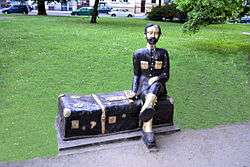Jan Czekanowski

Jan Czekanowski (October 8, 1882, Głuchów–July 20, 1965, Szczecin) was a Polish anthropologist, statistician and linguist. Czekanowski is known for having played an important role in saving the Polish-Lithuanian branch of the Karaim people from Holocaust extermination. In 1942 he managed to convince a German "race scientists" that the Karaim were of Turkic origin although professing Judaism and using Hebrew as a liturgical language. This helped the Karaim people escape the tragic destiny of other European Jews and the Romas.
Life
Czekanowski attended school in Warsaw but was transferred to Latvia, where he finished his education in 1901. He then entered a university in Zurich in 1902; there, he studied anthropology, mathematics, anatomy, and ethnography as a pupil of Swiss anthropologist Rudolph Martin, author of the popular anthropology textbook Lehrbuch der Anthropologie. In 1907 Czekanowski defended his PhD. dissertation. For the dissertation's research he traveled to the Royal Museum in Berlin and to Middle Africa from 1906-1907. While in Africa, he led a team into the Congo to collect ethnographic materials. While working on studying the societies of Africa, he developed various statistical methods and contributed to the field of taxonomy. The research he made in Africa has since been published in five volumes and sent in 1910 to Saint Petersburg ethnography. He then became a professor at the University of Lwów and University of Poznań. While working he introduced an innovative take on mathematical statistics. He worked in these universities from 1913 to 1945 and in the period 1923-1924 he was a president of Polish Copernicus Society of Naturalists. In addition, he worked at the University of Poznań from 1937-1946, where he researched the dynamics of evolution in human populations. He played numerous scientific roles at the University of Poznań, including vice-chairman of the Polish Social Statistic Company.
Racial classification
Czekanowski classified Europe into four pure races. The four pure races were the Nordic, Mediterranean (Ibero-Insular), Lapponoid and Armenoid. The Lapponoid included the central and eastern Europeans along Europe longitudely as well as the Sami people of Northern Europe.
Czekanowski classified six subraces in Europe which were mixed types of the pure races. The six mixed racial subraces were: the Northwestern (Nordic and Mediterranean), the Subnordic (Nordic and Lapponoid), Alpine (Lapponoid and Armenoid), the Littoral (Mediterranean and Armenoid), Sublapponoid (Mediterranean and Lapponoid) and the Dinaric (Nordic and Armenoid). The Sublapponoid subrace (also called Pile Dwelling race) lived around the Swiss lakes.[1]